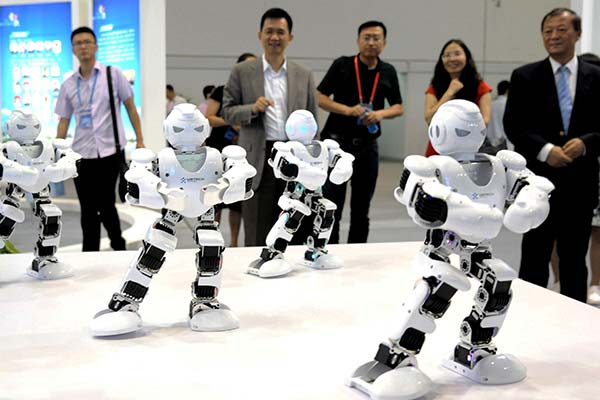 |
|
Robots on display at an industry expo in Suzhou, Jiangsu province, on July 10, 2016.[Photo/Xinhua] |
It is able to write calligraphy with a brush and is one of the star exhibits at the three-day China National Robotics Development Forum 2016 in Chongqing, a major platform for Chinese robot makers to showcase their competitiveness.
Liang Jinlong, sales manager of the Beijing Up-tech Harmony Co, which designs and makes the machine, said the company mainly builds robots to be used for educational purposes in schools and universities. It also provides other services, such as customized robots.
Liang is confident about the future of the company and the potential of the robotics industry in China due to the increasing interest from the public and the encouraging policy of the government.
The company was set up in 2013 in response to the robot fever. However, he is a little bit embarrassed when being asked about the revenue of the business, emphasizing the startup is paying more attention to winning more markets, rather than gaining profits.
Paul Ni, a principal at consulting firm Roland Berger, said that despite a late start, the robotics industry in China has enjoyed a large and rapid boost thanks to favorable policies. In the past years the public has also shown greater interest in robots and artificial intelligence than ever before, especially after some remarkable wins by the AlphaGo game-playing program against a South Korean go master, Ni said.
Sun Youxian, the former director-general of the Chinese Association of Automation, agreed with Paul, saying the industry is still facing challenges. Robotics has become a key part of the trend toward informatization and industrialization, and the technology has become the weather vane of the innovation and development of an intelligent society.
A little robot from Guangdong Libin Medical Science and Technology Co may cause experts to be concerned in other ways. The company produces a medical recovery robot-but it's essentially just an app in a pad, built into a robot-shaped shell. Patients even have to input their own temperature and blood pressure manually.
Gao Zhiwei, deputy general manager of Libin, said: "The current robot could be regarded as the first generation. It doesn't have many robotic functions because the company is making lots of efforts to build up the smart ecosystem, which is the most important and most difficult function for such medical robots."
Gao said the company has 50 employees, 20 of whom are research personnel, and they have started to design the second-generation robot with an HD camera and some basic robotic functions, such as walking and voice control.
He is confident about the future of his product, saying as long as Chinese policy toward the robotics industry doesn't change too much, the recovery robot will represent the trend of the modern medical service.
Ni said lots of startups want to enter the industry and profit from the hot market, but he doesn't think all of them are ready, either technologically or in terms of manufacturing. "It's good that Chinese robot companies have high confidence in themselves. But, these enterprises should realize there is still a huge gap between them and the United States and European robotics industries.
Many of them still don't have the ability to compete in the market, either at home and abroad," Ni said. "Therefore, improving and updating technology means a lot to them."
